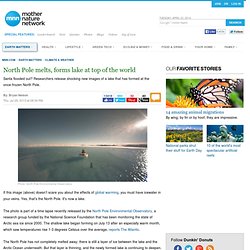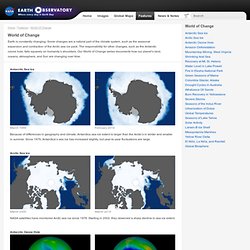

North Pole melts, forms lake at top of the world. If this image (above) doesn't scare you about the effects of global warming, you must have icewater in your veins.

Yes, that's the North Pole. It's now a lake. The photo is part of a time lapse recently released by the North Pole Environmental Observatory, a research group funded by the National Science Foundation that has been monitoring the state of Arctic sea ice since 2000. The shallow lake began forming on July 13 after an especially warm month, which saw temperatures rise 1-3 degrees Celsius over the average, reports The Atlantic. The North Pole has not completely melted away; there is still a layer of ice between the lake and the Arctic Ocean underneath.
Arctic ice has been retreating dramatically in recent years, opening up the fabled Northwest Passage, which can now be successfully navigated in the summer months. You can view the full time lapse taken by the research team at the North Pole, which shows the formation of the lake, below. Related on MNN: Earth From Space. Earth From Space PBS Airdate: February 13, 2013 NARRATOR: Our planet: Earth—you may think you know it well, but a startling new picture is emerging of a world shaped by forces more dynamic and intertwined than we ever imagined, raising possibilities that defy common sense.

How can sandstorms in the Sahara Desert transform the Amazon rainforest, over 5,000 miles away? In the frigid ocean beneath Antarctica, how can a vast undersea waterfall, 500 times bigger than Niagara Falls, lead to a gigantic feeding frenzy near the equator? And how can warm water, streaming past the coast of Africa, trigger a weather catastrophe, half a world away, in the southern United States?
Scientists have begun to find surprising answers to these and other profound questions, thanks to a network of satellites, orbiting high above the earth. EMILY SHUCKBURGH ( British Antarctic Survey): It’s really the last bastion of human discovery. NARRATOR: What are these hidden forces that rule our world? World of Change : Feature Articles. Earth is constantly changing.

Some changes are a natural part of the climate system, such as the seasonal expansion and contraction of the Arctic sea ice pack. The responsibility for other changes, such as the Antarctic ozone hole, falls squarely on humanity’s shoulders. Our World of Change series documents how our planet’s land, oceans, atmosphere, and Sun are changing over time. Antarctic Sea Ice March 1999 February 2014 Because of differences in geography and climate, Antarctica sea ice extent is larger than the Arctic’s in winter and smaller in summer.
Global warming, photography, pictures, photos, climate change, impact, science, weather, arctic, antarctica, climate zones, glacier, arctic warming, antarctica warming, documentation, effects, effects of climate change, paleoclimate, mountain glaciers, co.